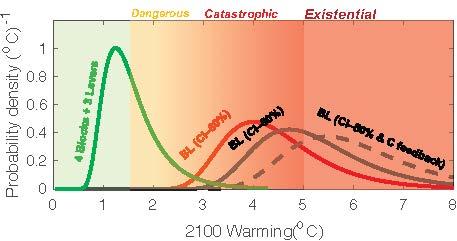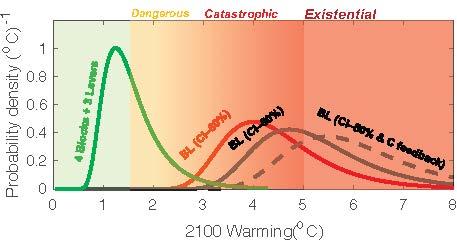
Credit: Scripps Institution of Oceanography at UC San Diego
A new study evaluating models of future climate scenarios has led to the creation of the new risk categories "catastrophic" and "unknown" to characterize the range of threats posed by rapid global warming. Researchers propose that unknown risks imply existential threats to the survival of humanity.
These categories describe two low-probability but statistically significant scenarios that could play out by century's end, in a new study by Veerabhadran Ramanathan, a distinguished professor of climate and atmospheric sciences at Scripps Institution of Oceanography at the University of California San Diego, and his former Scripps graduate student Yangyang Xu, now an assistant professor at Texas A&M University.
The risk assessment stems from the objective stated in the 2015 Paris Agreement regarding climate change that society keep average global temperatures "well below" a 2°C (3.6°F) increase from what they were before the Industrial Revolution.
Even if that objective is met, a global temperature increase of 1.5°C (2.7°F) is still categorized as "dangerous," meaning it could create substantial damage to human and natural systems. A temperature increase greater than 3°C (5.4°F) could lead to what the researchers term "catastrophic" effects, and an increase greater than 5°C (9°F) could lead to "unknown" consequences which they describe as beyond catastrophic including potentially existential threats. The specter of existential threats is raised to reflect the grave risks to human health and species extinction from warming beyond 5° C, which has not been experienced for at least the past 20 million years.
The scientists term warming probability of five percent or less as a "low-probability high-impact" scenario and assess such scenarios in the analysis "Well Below 2°C: Mitigation strategies for avoiding dangerous to catastrophic climate changes," which will appear in the journal Proceedings of the National Academy of Sciences on Sept. 14.
Ramanathan and Xu also describe three strategies for preventing the gravest threats from taking place.
"When we say five percent-probability high-impact event, people may dismiss it as small but it is equivalent to a one-in-20 chance the plane you are about to board will crash," said Ramanathan. "We would never get on that plane with a one-in-20 chance of it coming down but we are willing to send our children and grandchildren on that plane."
The researchers defined the risk categories based on guidelines established by the Intergovernmental Panel on Climate Change (IPCC) and previous independent studies. "Dangerous" global warming includes consequences such as increased risk of extreme weather and climate events ranging from more intense heat waves, hurricanes, and floods, to prolonged droughts. Planetary warming between 3°C and 5°C could trigger what scientists term "tipping points" such as the collapse of the West Antarctic Ice Sheet and subsequent global sea-level rise, and the dieback of the Amazon rainforest. In human systems, catastrophic climate change is marked by deadly heat waves becoming commonplace, exposing over 7 billion people to heat related mortalities and famine becoming widespread. Furthermore, the changes will be too rapid for most to adapt to, particularly the less affluent, said Ramanathan.
Risk assessments of global temperature rise greater than 5°C have not been undertaken by the IPCC. Ramanathan and Xu named this category "unknown??" with the question marks acknowledging the "subjective nature of our deduction." The existential threats could include species extinctions and major threats to human water and food supplies in addition to the health risks posed by exposing over 7 billion people worldwide to deadly heat.
With these scenarios in mind, the researchers identified what measures can be taken to slow the rate of global warming to avoid the worst consequences, particularly the low-probability high-impact events. Aggressive measures to curtail the use of fossil fuels and emissions of so-called short-lived climate pollutants such as soot, methane and HFCs would need to be accompanied by active efforts to extract CO2 from the air and sequester it before it can be emitted. It would take all three efforts to meet the Paris Agreement goal to which countries agreed at a landmark United Nations climate conference in Nov 2015.
Xu and Ramanathan point out that the goal is attainable. Global CO2 emissions had grown at a rate of 2.9 percent per year between 2000 and 2011, but had slowed to a near-zero growth rate by 2015. They credited drops in CO2 emissions from the United States and China as the primary drivers of the trend. Increases in production of renewable energy, especially wind and solar power, have also bent the curve of emissions trends downward. Other studies have estimated that there was by 2015 enough renewable energy capacity to meet nearly 24 percent of global electricity demand.
Short-lived climate pollutants are so called because even though they warm the planet more efficiently than carbon dioxide, they only remain in the atmosphere for a period of weeks to roughly a decade whereas carbon dioxide molecules remain in the atmosphere for a century or more. The authors also note that most of the technologies needed to drastically curb emissions of short-lived climate pollutants already exist and are in use in much of the developed world. They range from cleaner diesel engines to methane-capture infrastructure.
"While these are encouraging signs, aggressive policies will still be required to achieve carbon neutrality and climate stability," the authors wrote.
The release of the study coincides with the start of Climate Week NYC in New York, a summit of business and government leaders to highlight global climate action. Ramanathan and colleagues will deliver a complementary report detailing the "three-lever" mitigation strategy of emissions control and carbon sequestration on Sept. 18 at the United Nations. That report was produced by the Committee to Prevent Extreme Climate Change, chaired by Ramanathan, Nobel Prize winner Mario Molina of UC San Diego, and Durwood Zaelke, who leads an advocacy organization, the Institute for Governance and Sustainable Development, with 30 experts from around the world including China and India.
###
About UC San Diego
At the University of California San Diego, we constantly push boundaries and challenge expectations. Established in 1960, UC San Diego has been shaped by exceptional scholars who aren't afraid to take risks and redefine conventional wisdom. Today, as one of the top 15 research universities in the world, we are driving innovation and change to advance society, propel economic growth, and make our world a better place. Learn more at http://www.ucsd.edu.
About Scripps Institution of Oceanography
Scripps Institution of Oceanography at the University of California San Diego, is one of the most important centers for global science research and education in the world. Now in its second century of discovery, the scientific scope of the institution includes biological, physical, chemical, geological, geophysical, and atmospheric studies of the earth as a system. Hundreds of research programs to further our understanding of the planet are under way today on every continent and in every ocean. Birch Aquarium at Scripps serves as the interpretive center of the institution and showcases Scripps research and a diverse array of marine life for more than 430,000 visitors each year. Learn more at scripps.ucsd.edu.
Media Contact
Rob Monroe
[email protected]
858-534-3624
@UCSanDiego
http://www.ucsd.edu
Original Source
https://scripps.ucsd.edu/news/new-climate-risk-classification-created-account-potential-existential-threats





